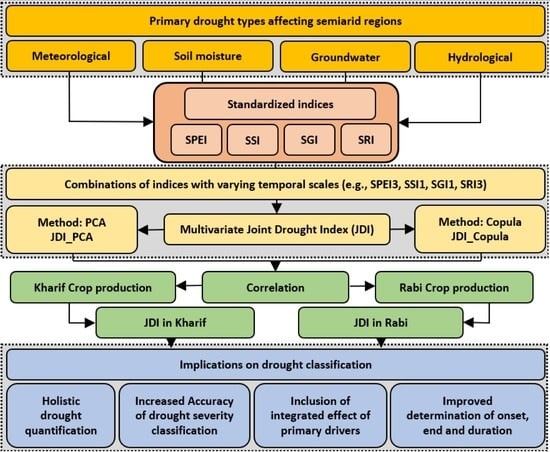A Multivariate Drought Index for Seasonal Agriculture Drought Classification in Semiarid Regions
Abstract
:1. Introduction
2. Materials and Methods
2.1. Data
2.1.1. Precipitation and Temperature
2.1.2. Soil Moisture
2.1.3. Groundwater Storage
2.1.4. Surface Runoff
2.1.5. Crop Production
2.1.6. Administrative Boundaries
2.2. Methodology
2.2.1. Principal Component Analysis (JDI_PCA)
2.2.2. Copula (JDI_Copula)
2.2.3. Integration of the Indices in JDI
2.3. Case Study Region
3. Results
3.1. Selected Combination of Indices for JDI
3.2. JDI Based on PCA (JDI_PCA)
3.3. JDI Based on Copula (JDI_Copula)
3.4. Seasonal Analysis of the Drought Intensities
3.4.1. Kharif Season
3.4.2. Rabi Season
3.5. Multiseason and Multiyear Droughts
3.6. Prediction of CP from JDI
4. Discussion
5. Limitations and Future Scope
6. Conclusions
- Unlike traditional indices, JDI efficiently captured the combined effect of drought variability in the study region. Moreover, the dynamics of seasonal CP and JDI corroborate each other, showing the advantages of using separate JDI for drought analysis in each season. JDI_Copula performed better in detecting the extreme drought characteristics by each integrated variable by preserving their dependence structure than JDI_PCA, which averaged the responses.
- Groundwater, being the primary source of irrigation, is an important driver of droughts over Marathwada, shaping the regional drought characteristics. JDI successfully captured this contribution, revealing its potential to support local-scale decision making and the ability to be evolved for any region having different hydroclimatic conditions by integrating locally critical inputs (e.g., snow accumulation, reservoir storage, fire risks, etc.).
- Multivariate indices are more efficient in capturing overall water deficit from multiple drought-related indices compared to a univariate index. JDI, as presented in this study, can play a crucial role in drought analysis with improved accuracy of detection of each drought type and comprehensive inclusion of various seasonal drought characteristics.
- JDI proves to be efficient in detecting the onset, termination, and duration of drought based on the integrated effect of multiple drought indicators, which otherwise was difficult to analyze. Out of drought characteristics captured by both the methods, droughts of the years 2015–2016 and 2018–2019 were the most severe in the study region.
- The results of this study also highlight the importance of a multidisciplinary approach in drought classification, which can play a crucial role in policy formation and food security, by providing a timely and accurate estimation of drought characteristics by reducing the inherent inconsistencies in the traditional methods. This is also important for the socioeconomic security of vulnerable regions, such as Marathwada, experiencing increased suffering of the farmers.
Supplementary Materials
Author Contributions
Funding
Data Availability Statement
Acknowledgments
Conflicts of Interest
References
- UNCCD. Drought in Numbers 2022—Restoration for Readiness and Resilience. Available online: https://www.unccd.int/sites/default/files/2022-05/DroughtinNumbers.pdf (accessed on 27 May 2022).
- Wilhite, D.A. (Ed.) Drought as a Natural Hazard. In Droughts, 1st ed.; Routledge: Oxfordshire, UK, 2000; pp. 3–18. [Google Scholar] [CrossRef]
- Guha-Sapir, D.; Below, R.; Hoyois, P. EM-DAT: The CRED/OFDA International Disaster Database. Available online: www.emdat.be (accessed on 27 May 2022).
- Mishra, A.K.; Singh, V.P. A Review of Drought Concepts. J. Hydrol. 2010, 391, 202–216. [Google Scholar] [CrossRef]
- Dai, A. Increasing Drought under Global Warming in Observations and Models. Nat. Clim. Chang. 2013, 3, 52–58. [Google Scholar] [CrossRef]
- Aadhar, S.; Mishra, V. Impact of Climate Change on Drought Frequency over India. In Climate Change and Water Resources in India; Ministry of Environment, Forest and Climate Change: New Delhi, India, 2018; pp. 117–129. [Google Scholar]
- Bloomfield, J.P.; Marchant, B.P.; McKenzie, A.A. Changes in Groundwater Drought Associated with Anthropogenic Warming. Hydrol. Earth Syst. Sci. 2019, 23, 1393–1408. [Google Scholar] [CrossRef]
- Government of India. Manual for Drought Management; Ministry of Agriculture and Farmers Welfare: New Delhi, India, 2016. [Google Scholar]
- Bageshree, K.; Abhishek; Kinouchi, T. Unraveling the Multiple Drivers of Greening-Browning and Leaf Area Variability in a Socioeconomically Sensitive. Climate 2022, 10, 70. [Google Scholar] [CrossRef]
- Talule, D. Farmer Suicides in Maharashtra, 2001-2018 Trends across Marathwada and Vidarbha. Econ. Polit. Wkly. 2020, 55, 1538–1545. [Google Scholar]
- Talule, D. Suicide by Maharashtra Farmers, The Signs of Persistent Agrarian Distress. Econ. Polit. Wkly. 2021, 56, 10. [Google Scholar]
- Merriott, D. Factors Associated with the Farmer Suicide Crisis in India. J. Epidemiol. Glob. Health 2016, 6, 217–227. [Google Scholar] [CrossRef]
- Nagaraj, K.; Sainath, P.; Rukmani, R.; Gopinath, R. Farmers’ Suicides in India: Magnitudes, Trends, and Spatial Patterns, 1997–2012. Rev. Agrar. Stud. 2014, 4, 1997–2012. [Google Scholar]
- Iyer, K. Landscapes of Loss: The Story of an Indian Drought; HarperCollins Publishers: Nodia, India, 2021; ISBN 9390327466. [Google Scholar]
- Mishra, V.; Tiwari, A.D.; Aadhar, S.; Shah, R.; Xiao, M.; Pai, D.S.; Lettenmaier, D. Drought and Famine in India, 1870–2016. Geophys. Res. Lett. 2019, 46, 2075–2083. [Google Scholar] [CrossRef]
- Rodell, M.; Velicogna, I.; Famiglietti, J.S. Satellite-Based Estimates of Groundwater Depletion in India. Nature 2009, 460, 999–1002. [Google Scholar] [CrossRef]
- Asoka, A.; Mishra, V. A Strong Linkage between Seasonal Crop Growth and Groundwater Storage Variability in India. J. Hydrometeorol. 2020, 22, 125–138. [Google Scholar] [CrossRef]
- Aghakouchak, A.; Farahmand, A.; Melton, F.S.; Teixeira, J.; Anderson, M.C.; Wardlow, B.D.; Hain, C.R. Reviews of Geophysics Remote Sensing of Drought: Progress, Challenges. Rev. Geophys. 2015, 53, 1–29. [Google Scholar] [CrossRef]
- Palmer, W.C. Keeping Track of Crop Moisture Conditions, Nationwide: The New Crop Moisture Index. Weatherwise 2010, 21, 156–161. [Google Scholar] [CrossRef]
- Mckee, T.B.; Doesken, N.J.; Kleist, J. The relationship of drought frequency and duration to time scales. In Proceedings of the Eighth Conference on Applied Climatology, Anaheim, CA, USA, 17–22 January 1993; pp. 17–22. [Google Scholar]
- Vicente-Serrano, S.M.; Beguería, S.; López-Moreno, J.I. A Multiscalar Drought Index Sensitive to Global Warming: The Standardized Precipitation Evapotranspiration Index. J. Clim. 2010, 23, 1696–1718. [Google Scholar] [CrossRef]
- Kogan, F.N. Remote Sensing of Weather Impacts on Vegetation in Non-Homogeneous Areas. Int. J. Remote Sens. 1990, 11, 1405–1419. [Google Scholar] [CrossRef]
- Burgan, R.E.; Hartford, R.A.; Eidenshink, J.C. Using NDVI to Assess Departure From Average Greenness and Its Relation to Fire Business the Authors; Intermountain Research Station: Ogden, UT, USA, 1996. [Google Scholar]
- Kogan, F.N. Application of Vegetation Index and Brightness Temperature for Drought Detection. Adv. Sp. Res. 1995, 15, 91–100. [Google Scholar] [CrossRef]
- Kogan, F.; Sullivan, J. Development of Global Drought-Watch System Using NOAA/AVHRR Data. Adv. Sp. Res. 1993, 13, 219–222. [Google Scholar] [CrossRef]
- Anderson, M.C.; Norman, J.M.; Mecikalski, J.R.; Otkin, J.A.; Kustas, W.P. A Climatological Study of Evapotranspiration and Moisture Stress across the Continental United States Based on Thermal Remote Sensing: 2. Surface Moisture Climatology. J. Geophys. Res. Atmos. 2007, 112, D11112. [Google Scholar] [CrossRef]
- Anderson, M.C.; Hain, C.; Wardlow, B.; Pimstein, A.; Mecikalski, J.R.; Kustas, W.P. Evaluation of Drought Indices Based on Thermal Remote Sensing of Evapotranspiration over the Continental United States. J. Clim. 2011, 24, 2025–2044. [Google Scholar] [CrossRef]
- WMO (World Meteorological Organization). Partnership, Global Water Handbook of Drought Indicators and Indices; Integrated Drought Management Programme, Integrated Drought Management Tools and Guidelines Series 2; WMO: Geneva, Switzerland, 2016. [Google Scholar]
- Wardlow, B.; Anderson, M.; Hain, C.; Crow, W.; Otkin, J.; Tadesse, T.; AghaKouchak, A. Advancements in Satellite Remote Sensing for Drought Monitoring; CRC Press: Boca Raton, FL, USA, 2017; ISBN 9781315265551. [Google Scholar]
- Tadesse, T.; Brown, J.F.; Hayes, M.J. A New Approach for Predicting Drought-Related Vegetation Stress: Integrating Satellite, Climate, and Biophysical Data over the U.S. Central Plains. ISPRS J. Photogramm. Remote Sens. 2005, 59, 244–253. [Google Scholar] [CrossRef]
- Brown, J.F.; Wardlow, B.D.; Tadesse, T.; Hayes, M.J.; Reed, B.C. The Vegetation Drought Response Index (VegDRI): A New Integrated Approach for Monitoring Drought Stress in Vegetation. GIScience Remote Sens. 2008, 45, 16–46. [Google Scholar] [CrossRef]
- Zhang, A.; Jia, G. Monitoring Meteorological Drought in Semiarid Regions Using Multi-Sensor Microwave Remote Sensing Data. Remote Sens. Environ. 2013, 134, 12–23. [Google Scholar] [CrossRef]
- Hao, Z.; Aghakouchak, A. A Nonparametric Multivariate Multi-Index Drought Monitoring Framework. J. Hydrometeorol. 2014, 15, 89–101. [Google Scholar] [CrossRef]
- Sepulcre-Canto, G.; Horion, S.; Singleton, A.; Carrao, H.; Vogt, J. Natural Hazards and Earth System Sciences Development of a Combined Drought Indicator to Detect Agricultural Drought in Europe. Hazards Earth Syst. Sci 2012, 12, 3519–3531. [Google Scholar] [CrossRef]
- Gupta, A.K.; Tyagi, P.; Sehgal, V.K. Drought Disaster Challenges and Mitigation in India: Strategic Appraisal. Curr. Sci. 2011, 100, 1795–1806. [Google Scholar]
- Bhardwaj, K.; Mishra, V. Drought Detection and Declaration in India. Water Secur. 2021, 14, 100104. [Google Scholar] [CrossRef]
- Abhishek; Kinouchi, T. Multidecadal Land Water and Groundwater Drought Evaluation in Peninsular India. Remote Sens. 2022, 14, 1486. [Google Scholar] [CrossRef]
- Panda, D.K.; Wahr, J. Spatiotemporal Evolution of Water Storage Changes in India from the Updated GRACE-Derived Gravity Records. Water Resour. Res. 2016, 52, 135–149. [Google Scholar] [CrossRef]
- Asoka, A.; Gleeson, T.; Wada, Y.; Mishra, V. Relative Contribution of Monsoon Precipitation and Pumping to Changes in Groundwater Storage in India. Nat. Geosci. 2017, 10, 109–117. [Google Scholar] [CrossRef]
- Dangar, S.; Asoka, A.; Mishra, V. Causes and Implications of Groundwater Depletion in India: A Review. J. Hydrol. 2021, 596, 126103. [Google Scholar] [CrossRef]
- Mishra, V.; Asoka, A. A Satellite-Based Assessment of the Relative Contribution of Hydroclimatic Variables on Vegetation Growth in Global Agricultural and Non-Agricultural Regions. J. Geophys. Res. 2011, 44, 1689–1699. [Google Scholar] [CrossRef]
- Rodell, M.; Houser, P.R.; Jambor, U.; Gottschalck, J.; Mitchell, K.; Meng, C.J.; Arsenault, K.; Cosgrove, B.; Radakovich, J.; Bosilovich, M.; et al. The Global Land Data Assimilation System. Bull. Am. Meteorol. Soc. 2004, 85, 381–394. [Google Scholar] [CrossRef]
- Girotto, M.; De Lannoy, G.J.M.; Reichle, R.H.; Rodell, M.; Draper, C.; Bhanja, S.N.; Mukherjee, A. Benefits and Pitfalls of GRACE Data Assimilation: A Case Study of Terrestrial Water Storage Depletion in India. Geophys. Res. Lett. 2017, 44, 4107–4115. [Google Scholar] [CrossRef] [PubMed]
- Shah, D.; Mishra, V. Integrated Drought Index (IDI) for Drought Monitoring and Assessment in India. Water Resour. Res. 2020, 56, e2019WR026284. [Google Scholar] [CrossRef]
- Li, B.; Rodell, M.; Kumar, S.; Beaudoing, H.K.; Getirana, A.; Zaitchik, B.F.; de Goncalves, L.G.; Cossetin, C.; Bhanja, S.; Mukherjee, A.; et al. Global GRACE Data Assimilation for Groundwater and Drought Monitoring: Advances and Challenges. Water Resour. Res. 2019, 55, 7564–7586. [Google Scholar] [CrossRef]
- Li, B.; Beaudoing, H.; Rodell, M. GLDAS Catchment Land Surface Model L4 Daily 0.25 × 0.25 Degree GRACE-DA1 V2.2, Greenbelt, Maryland, USA, Goddard Earth Sciences Data and Information Services Center (GES DISC). Goddard Earth Sci. Data Inf. Serv. Cent. (GES DISC) 2020, 16. [Google Scholar]
- Li, B.; Rodell, M. Evaluation of a Model-Based Groundwater Drought Indicator in the Conterminous, U.S. J. Hydrol. 2015, 526, 78–88. [Google Scholar] [CrossRef]
- Pai, D.S.; Sridhar, L.; Rajeevan, M.; Sreejith, O.P.; Satbhai, N.S.; Mukhopadhyay, B. Development of a New High Spatial Resolution (0.25° × 0.25°) Long Period (1901–2010) Daily Gridded Rainfall Data Set over India and Its Comparison with Existing Data Sets over the Region. Mausam 2014, 65, 1–18. [Google Scholar] [CrossRef]
- Shepard, D.S. Computer Mapping: The SYMAP Interpolation Algorithm. In Spatial Statistics and Models; Gaile, G.L., Willmott, C.J., Eds.; Springer: Dordrecht, The Netherlands, 1984; pp. 133–145. [Google Scholar]
- Shepard, D. A Two-Dimensional Interpolation for Irregularly-Spaced Data Function. In Proceedings of the 23rd ACM National Conference, New York, NY, USA, 27–29 August 1968; pp. 517–524. [Google Scholar]
- Moran, M.S. Thermal Infrared Measurement as an Indicator of Plant Ecosystem Health. In Thermal Remote Sensing in Land Surface Processes; CRC Press: Boca Raton, FL, USA, 2004; pp. 257–282. ISBN 9780429210518. [Google Scholar]
- Mishra, V.; Shah, R.; Azhar, S.; Shah, H.; Modi, P.; Kumar, R. Reconstruction of Droughts in India Using Multiple Land-Surface Models (1951–2015). Hydrol. Earth Syst. Sci. 2018, 22, 2269–2284. [Google Scholar] [CrossRef]
- Zhang, G.; Su, X.; Ayantobo, O.O.; Feng, K. Drought Monitoring and Evaluation Using ESA CCI and GLDAS-Noah Soil Moisture Datasets across China. Theor. Appl. Climatol. 2021, 144, 1407–1418. [Google Scholar] [CrossRef]
- Bi, H.; Ma, J.; Zheng, W.; Zeng, J. Comparison of Soil Moisture in GLDAS Model Simulations and in Situ Observations over the Tibetan Plateau. J. Geophys. Res. 2016, 121, 2658–2678. [Google Scholar] [CrossRef]
- Sathyanadh, A.; Karipot, A.; Ranalkar, M.; Prabhakaran, T. Evaluation of Soil Moisture Data Products over Indian Region and Analysis of Spatio-Temporal Characteristics with Respect to Monsoon Rainfall. J. Hydrol. 2016, 542, 47–62. [Google Scholar] [CrossRef]
- Mishra, V.; Shah, R.; Thrasher, B. Soil Moisture Droughts under the Retrospective and Projected Climate in India. J. Hydrometeorol. 2014, 15, 2267–2292. [Google Scholar] [CrossRef]
- Arora, V.K.; Boer, G.J. A Representation of Variable Root Distribution in Dynamic Vegetation Models. Earth Interact. 2003, 7, 1–19. [Google Scholar] [CrossRef]
- Qiu, J.; Crow, W.T.; Nearing, G.S. The Impact of Vertical Measurement Depth on the Information Content of Soil Moisture for Latent Heat Flux Estimation. J. Hydrometeorol. 2016, 17, 2419–2430. [Google Scholar] [CrossRef]
- Qiu, J.; Crow, W.T.; Nearing, G.S.; Mo, X.; Liu, S. The Impact of Vertical Measurement Depth on the Information Content of Soil Moisture Times Series Data. Geophys. Res. Lett. 2014, 41, 4997–5004. [Google Scholar] [CrossRef]
- Kulkarni, S.S.; Wardlow, B.D.; Bayissa, Y.A.; Tadesse, T.; Svoboda, M.D.; Gedam, S.S. Developing a Remote Sensing-Based Combined Drought Indicator Approach for Agricultural Drought Monitoring over Marathwada, India. Remote Sens. 2020, 12, 2091. [Google Scholar] [CrossRef]
- Hu, Z.; Chen, X.; Li, Y.; Zhou, Q.; Yin, G. Temporal and Spatial Variations of Soil Moisture Over Xinjiang Based on Multiple GLDAS Datasets. Front. Earth Sci. 2021, 9, 654848. [Google Scholar] [CrossRef]
- Hao, Z.; Singh, V.P. Drought Characterization from a Multivariate Perspective: A Review. J. Hydrol. 2015, 527, 668–678. [Google Scholar] [CrossRef]
- Hao, Z.; AghaKouchak, A. Multivariate Standardized Drought Index: A Parametric Multi-Index Model. Adv. Water Resour. 2013, 57, 12–18. [Google Scholar] [CrossRef]
- Ma, M.; Ren, L.; Singh, V.P.; Yang, X.; Yuan, F.; Jiang, S. New Variants of the Palmer Drought Scheme Capable of Integrated Utility. J. Hydrol. 2014, 519, 1108–1119. [Google Scholar] [CrossRef]
- Balacco, G.; Alfio, M.R.; Fidelibus, M.D. Groundwater Drought Analysis under Data Scarcity: The Case of the Salento Aquifer (Italy). Sustainability 2022, 14, 707. [Google Scholar] [CrossRef]
- Wang, S.; Liu, H.; Yu, Y.; Zhao, W.; Yang, Q.; Liu, J. Evaluation of Groundwater Sustainability in the Arid Hexi Corridor of Northwestern China, Using GRACE, GLDAS and Measured Groundwater Data Products. Sci. Total Environ. 2020, 705, 135829. [Google Scholar] [CrossRef] [PubMed]
- Ouma, Y.O.; Aballa, D.O.; Marinda, D.O.; Tateishi, R.; Hahn, M. Use of GRACE Time-Variable Data and GLDAS-LSM for Estimating Groundwater Storage Variability at Small Basin Scales: A Case Study of the Nzoia River Basin. Int. J. Remote Sens. 2015, 36, 5707–5736. [Google Scholar] [CrossRef]
- Qi, W.; Liu, J.; Yang, H.; Zhu, X.; Tian, Y.; Jiang, X.; Huang, X.; Feng, L. Large Uncertainties in Runoff Estimations of GLDAS Versions 2.0 and 2.1 in China. Earth Sp. Sci. 2020, 7, e2019EA000829. [Google Scholar] [CrossRef]
- Bai, P.; Liu, X.; Yang, T.; Liang, K.; Liu, C. Evaluation of Streamflow Simulation Results of Land Surface Models in GLDAS on the Tibetan Plateau. J. Geophys. Res. 2016, 121, 12180–12197. [Google Scholar] [CrossRef]
- Panu, U.S.; Sharma, T.C. Challenges in Drought Research: Some Perspectives and Future Directions. Hydrol. Sci. J. 2002, 47, S19–S30. [Google Scholar] [CrossRef]
- Hidalgo, H.G.; Piechota, T.C.; Dracup, J.A. Alternative Principal Components Regression Procedures for Dendrohydrologic Reconstructions. Water Resour. Res. 2000, 36, 3241–3249. [Google Scholar] [CrossRef]
- Keyantash, J.A.; Dracup, J.A. An Aggregate Drought Index: Assessing Drought Severity Based on Fluctuations in the Hydrologic Cycle and Surface Water Storage. Water Resour. Res. 2004, 40, 1–14. [Google Scholar] [CrossRef]
- Maity, R. Statistical Methods in Hydrology and Hydroclimatology; Springer Transactions in Civil and Environmental Engineering, Springer: Singapore, 2018; ISBN 9789811087783. [Google Scholar]
- Nelson, R.B. (Ed.) An Introduction to Copulas, 2nd ed.; Springer: New York, NY, USA, 2006; ISBN 9780387286594. [Google Scholar]
- Kavianpour, M.; Seyedabadi, M.; Moazami, S. Spatial and Temporal Analysis of Drought Based on a Combined Index Using Copula. Environ. Earth Sci. 2018, 77, 769. [Google Scholar] [CrossRef]
- Kao, S.C.; Govindaraju, R.S. Trivariate Statistical Analysis of Extreme Rainfall Events via the Plackett Family of Copulas. Water Resour. Res. 2008, 44, 1–19. [Google Scholar] [CrossRef]
- Kao, S.C.; Govindaraju, R.S. A Copula-Based Joint Deficit Index for Droughts. J. Hydrol. 2010, 380, 121–134. [Google Scholar] [CrossRef]
- Ayantobo, O.O.; Li, Y.; Song, S. Multivariate Drought Frequency Analysis Using Four-Variate Symmetric and Asymmetric Archimedean Copula Functions. Water Resour. Manag. 2019, 33, 103–127. [Google Scholar] [CrossRef]
- Song, S.; Singh, V.P. Meta-Elliptical Copulas for Drought Frequency Analysis of Periodic Hydrologic Data. Stoch. Environ. Res. Risk Assess. 2010, 24, 425–444. [Google Scholar] [CrossRef]
- Sklar, M. Fonctions de Repartition a n Dimensions et Leurs Marges; CiNii Research. Publ. De L’institut De Stat. De L’université De Paris 1959, 8, 229–231. [Google Scholar]
- Delignette-Muller, M.L.; Dutang, C. Fitdistrplus: An R Package for Fitting Distributions. J. Stat. Softw. 2015, 64, 1–34. [Google Scholar] [CrossRef]
- Ma, J.; Sun, Z. Mutual Information Is Copula Entropy. Tsinghua Sci. Technol. 2011, 16, 51–54. [Google Scholar] [CrossRef]
- Genest, C.; Quessy, J.F.; Rémillard, B. Goodness-of-Fit Procedures for Copula Models Based on the Probability Integral Transformation. Scand. J. Stat. 2006, 33, 337–366. [Google Scholar] [CrossRef]
- Minea, I.; Iosub, M.; Boicu, D. Multi-Scale Approach for Different Type of Drought in Temperate Climatic Conditions. Nat. Hazards 2022, 110, 1153–1177. [Google Scholar] [CrossRef]
- Apurv, T.; Sivapalan, M.; Cai, X. Understanding the Role of Climate Characteristics in Drought Propagation. Water Resour. Res. 2017, 53, 9304–9329. [Google Scholar] [CrossRef]
- Shukla, S.; Wood, A.W. Use of a Standardized Runoff Index for Characterizing Hydrologic Drought. Geophys. Res. Lett. 2008, 35, 1–7. [Google Scholar] [CrossRef]
- Svoboda, M.; LeComte, D.; Hayes, M.; Heim, R.; Gleason, K.; Angel, J.; Stephens, S. The drought monitor. Bull. Am. Meteorol. Soc. 2002, 83, 1181–1190. [Google Scholar] [CrossRef]
- Mo, K.C. Drought Onset and Recovery over the United States. J. Geophys. Res. Atmos. 2011, 116, D20106. [Google Scholar] [CrossRef]
- Government of Maharashtra. Kelkar Committee’s Report on Balanced Regional Development Issues in Maharashtra; Government of Maharashtra: Maharashtra, India, 2013. Available online: https://mahasdb.maharashtra.gov.in/kelkarCommittee.do (accessed on 13 March 2022).
- Abhishek; Kinouchi, T. Synergetic Application of GRACE Gravity Data, Global Hydrological Model, and in-Situ Observations to Quantify Water Storage Dynamics over Peninsular India during 2002–2017. J. Hydrol. 2021, 596, 126069. [Google Scholar] [CrossRef]
- Xiong, J.; Abhishek; Guo, S.; Kinouchi, T. Leveraging Machine Learning Methods to Quantify 50 Years of Dwindling Groundwater in India. Sci. Total Environ. 2022, 835, 155474. [Google Scholar] [CrossRef]
- Kulkarni, A.; Gadgil, S.; Patwardhan, S. Monsoon Variability, the 2015 Marathwada Drought and Rainfed Agriculture. Curr. Sci. 2016, 111, 1182–1193. [Google Scholar] [CrossRef]
- Xu, Y.; Zhang, X.; Hao, Z.; Singh, V.P.; Hao, F. Characterization of Agricultural Drought Propagation over China Based on Bivariate Probabilistic Quantification. J. Hydrol. 2021, 598, 126194. [Google Scholar] [CrossRef]
- Azhdari, Z.; Bazrafshan, J. A Hybrid Drought Index for Assessing Agricultural Drought in Arid and Semi-Arid Coastal Areas of Southern Iran. Int. J. Environ. Sci. Technol. 2022. [Google Scholar] [CrossRef]
- Orimoloye, I.R. Agricultural Drought and Its Potential Impacts: Enabling Decision-Support for Food Security in Vulnerable Regions. Front. Sustain. Food Syst. 2022, 6, 838824. [Google Scholar] [CrossRef]

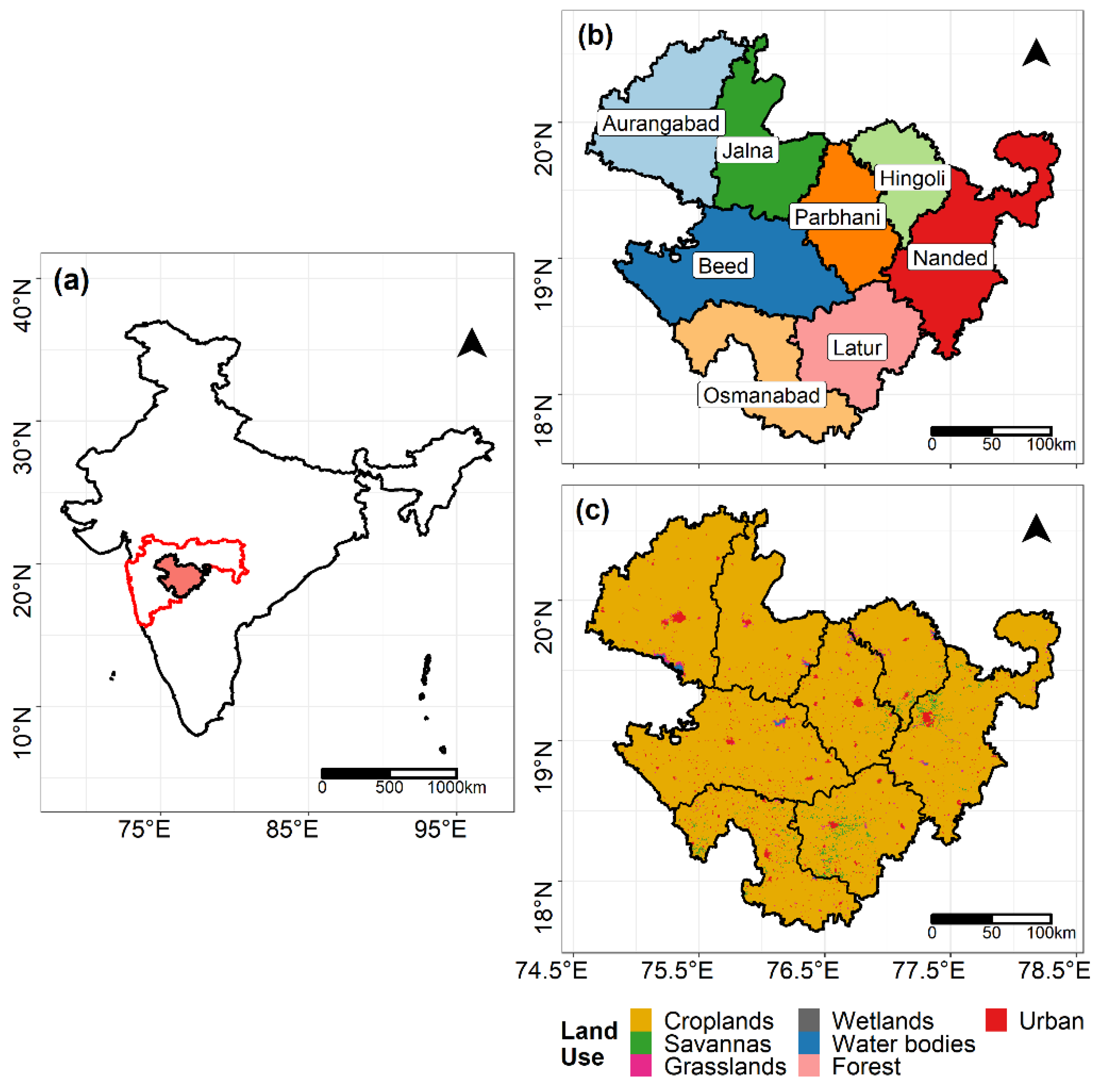
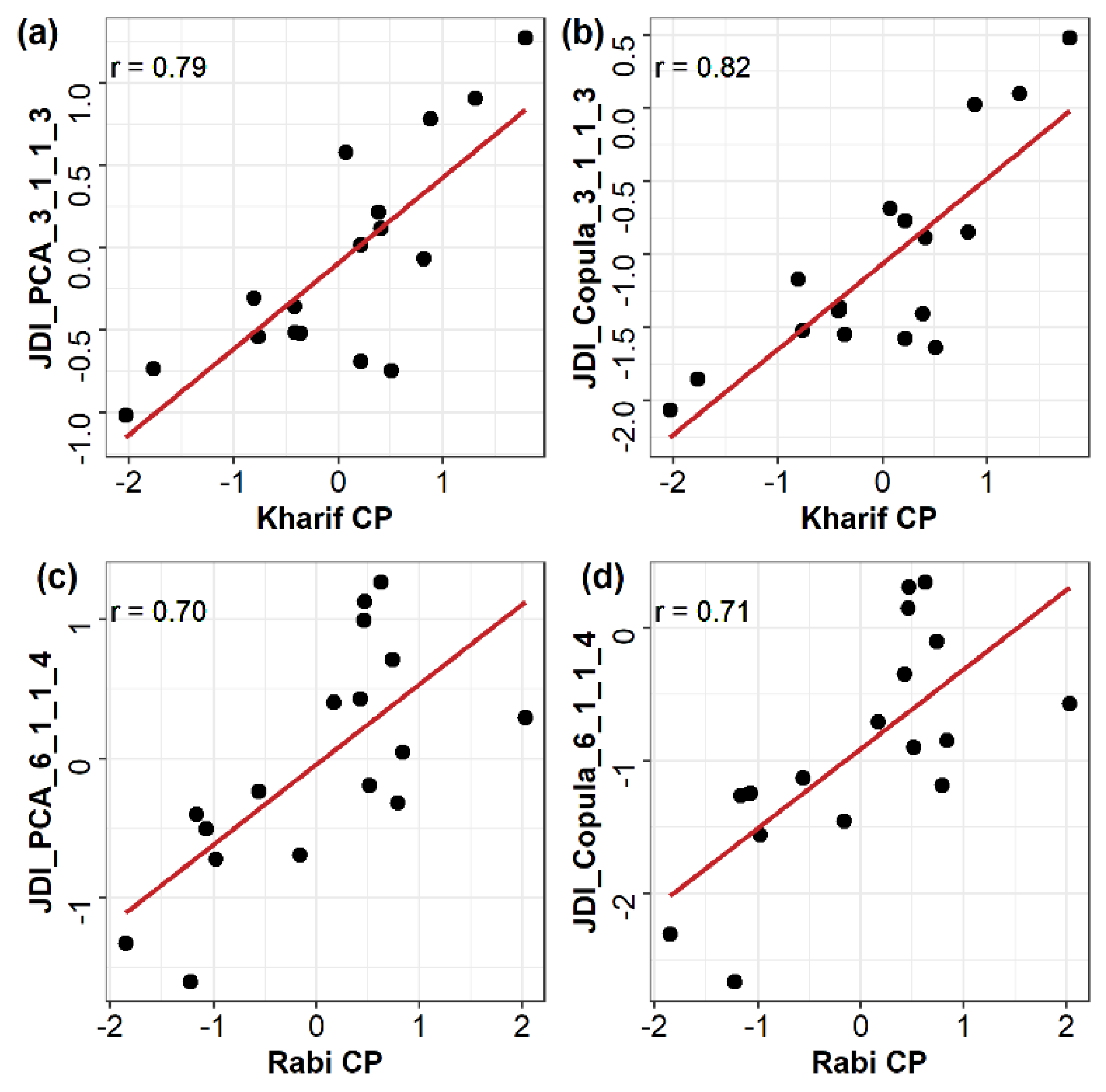

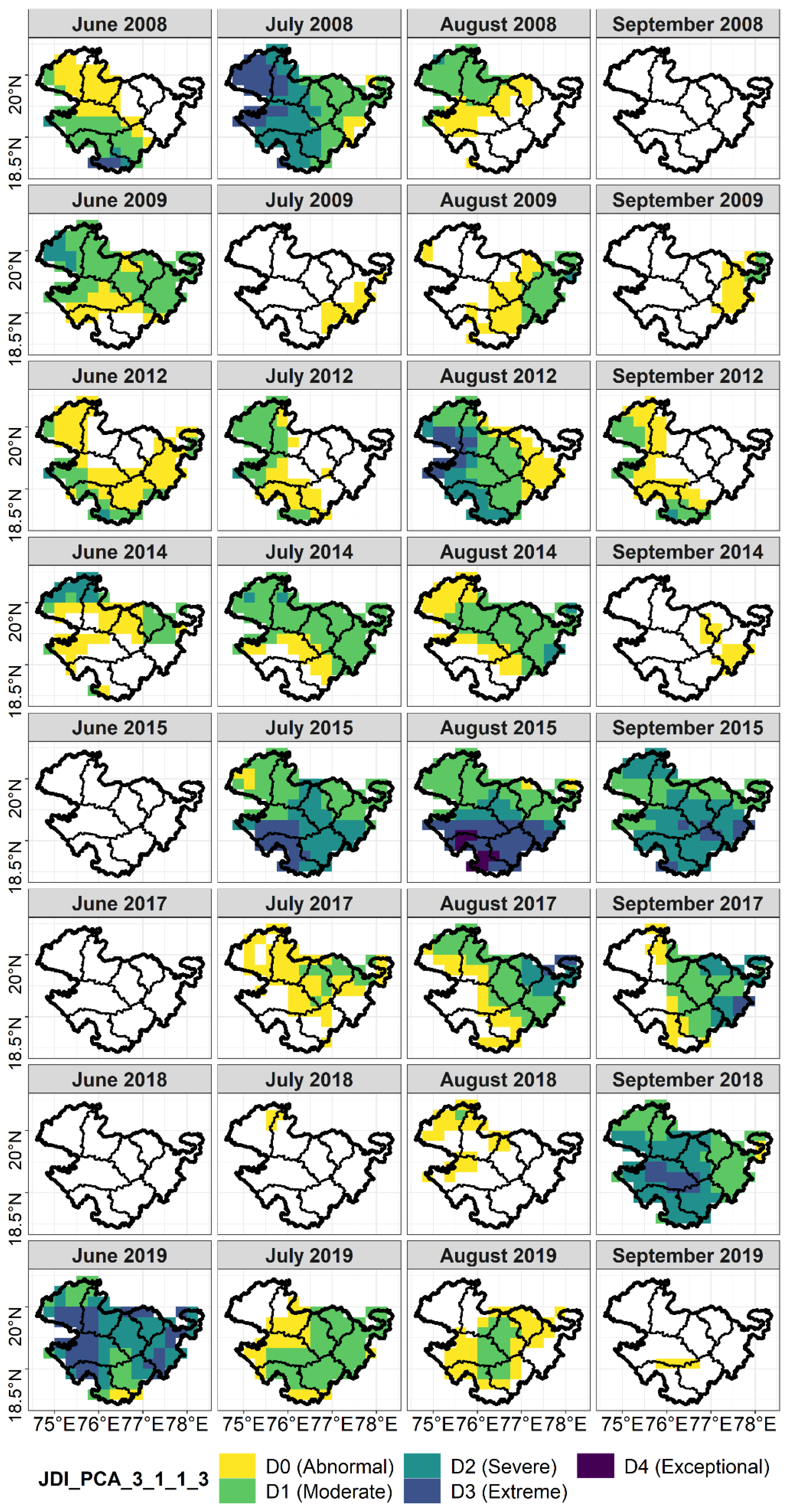
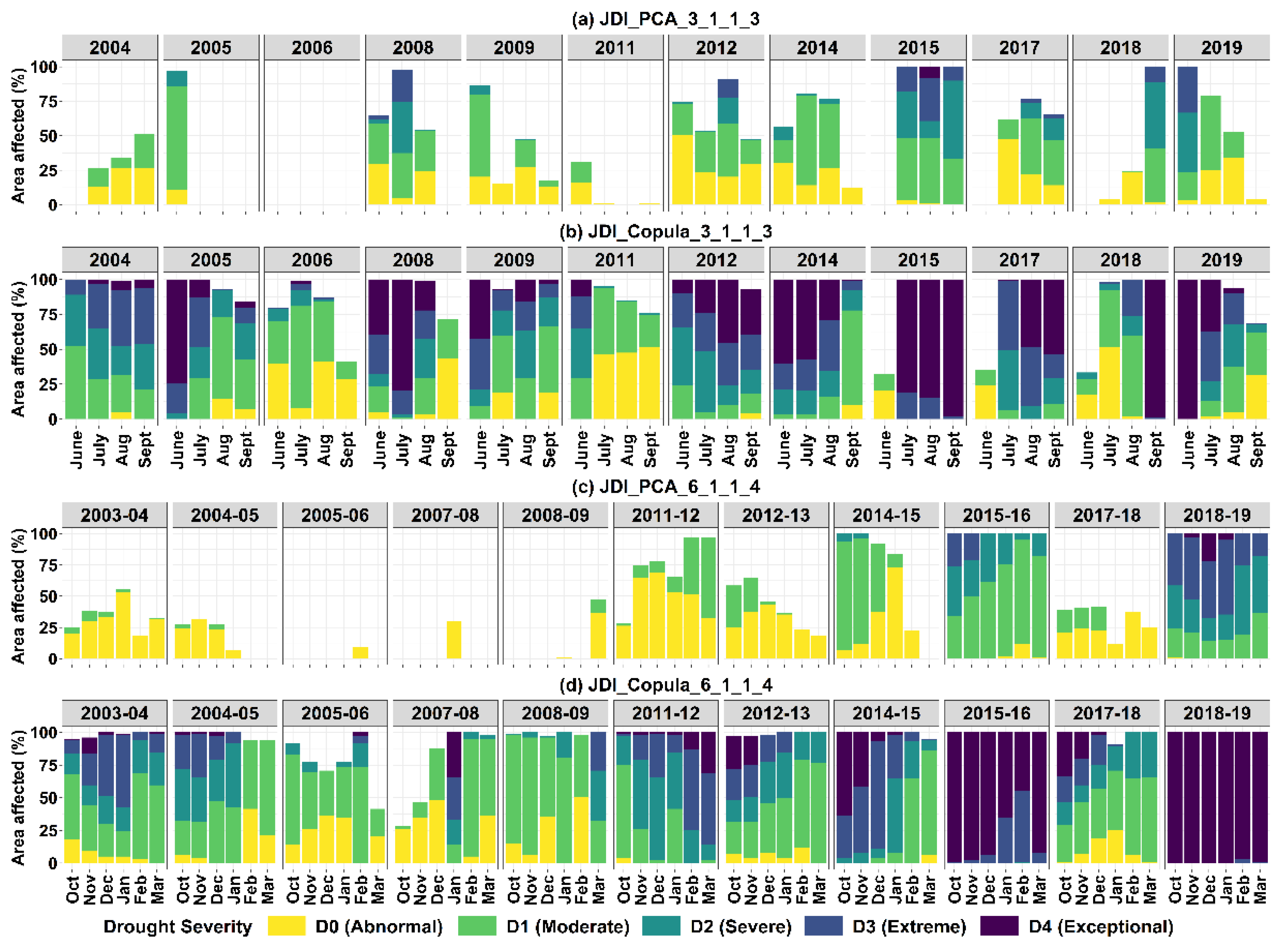
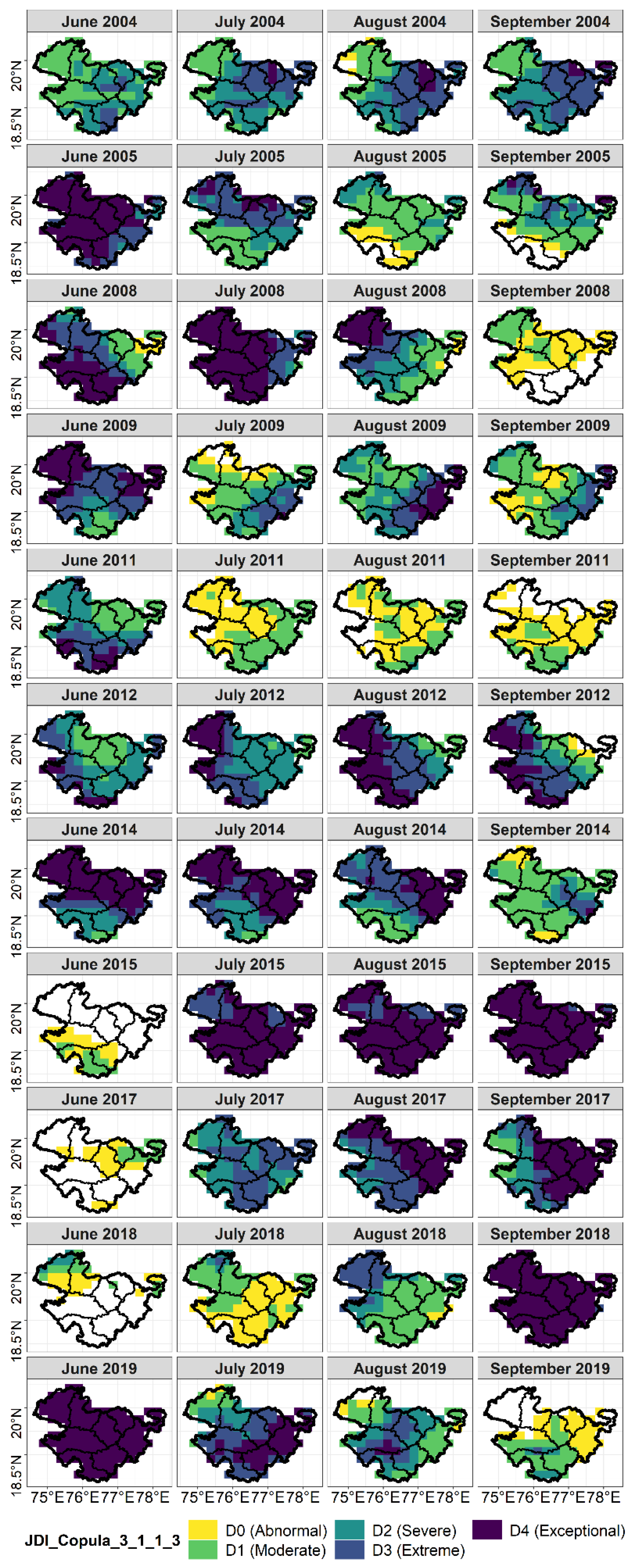
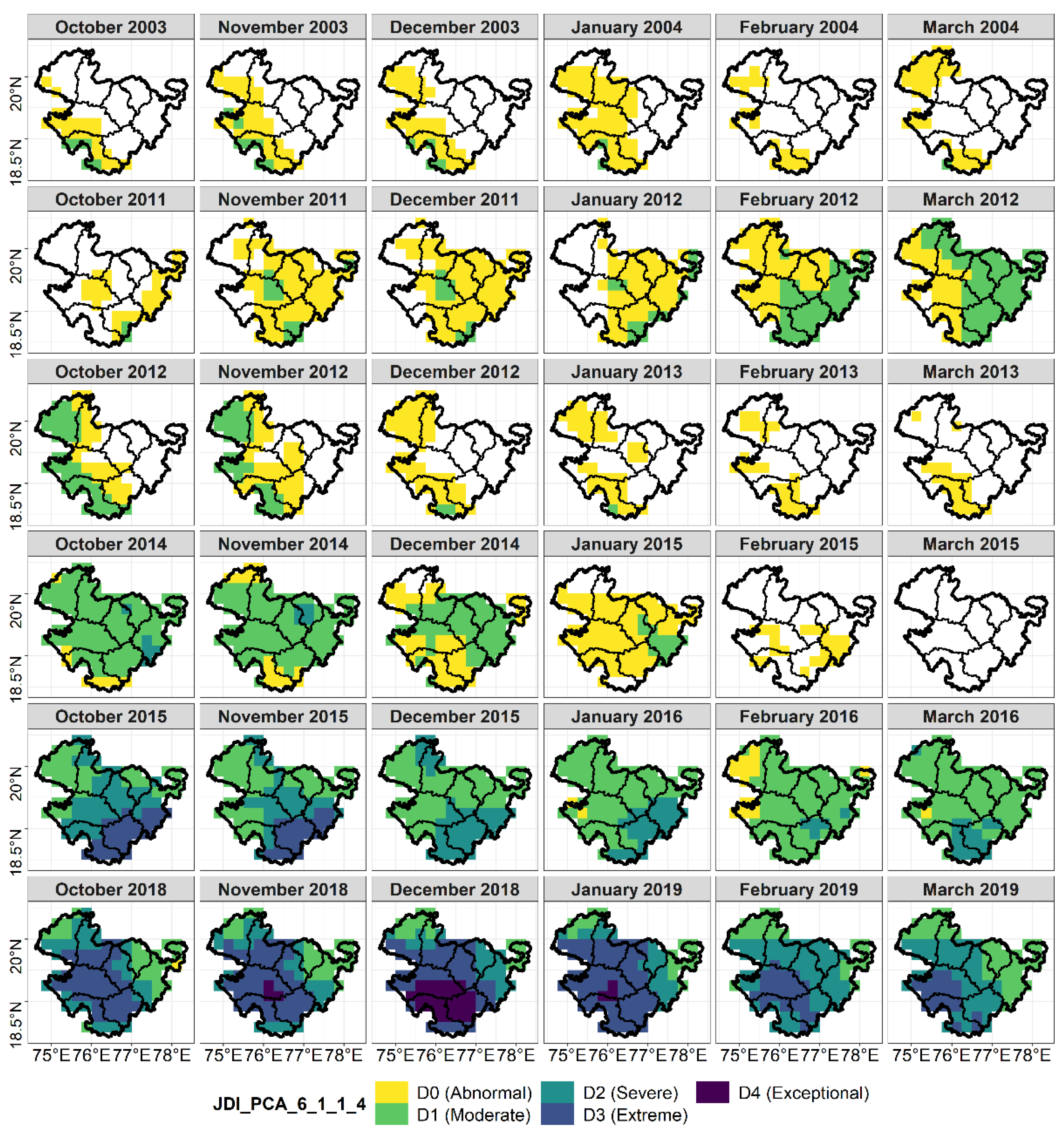
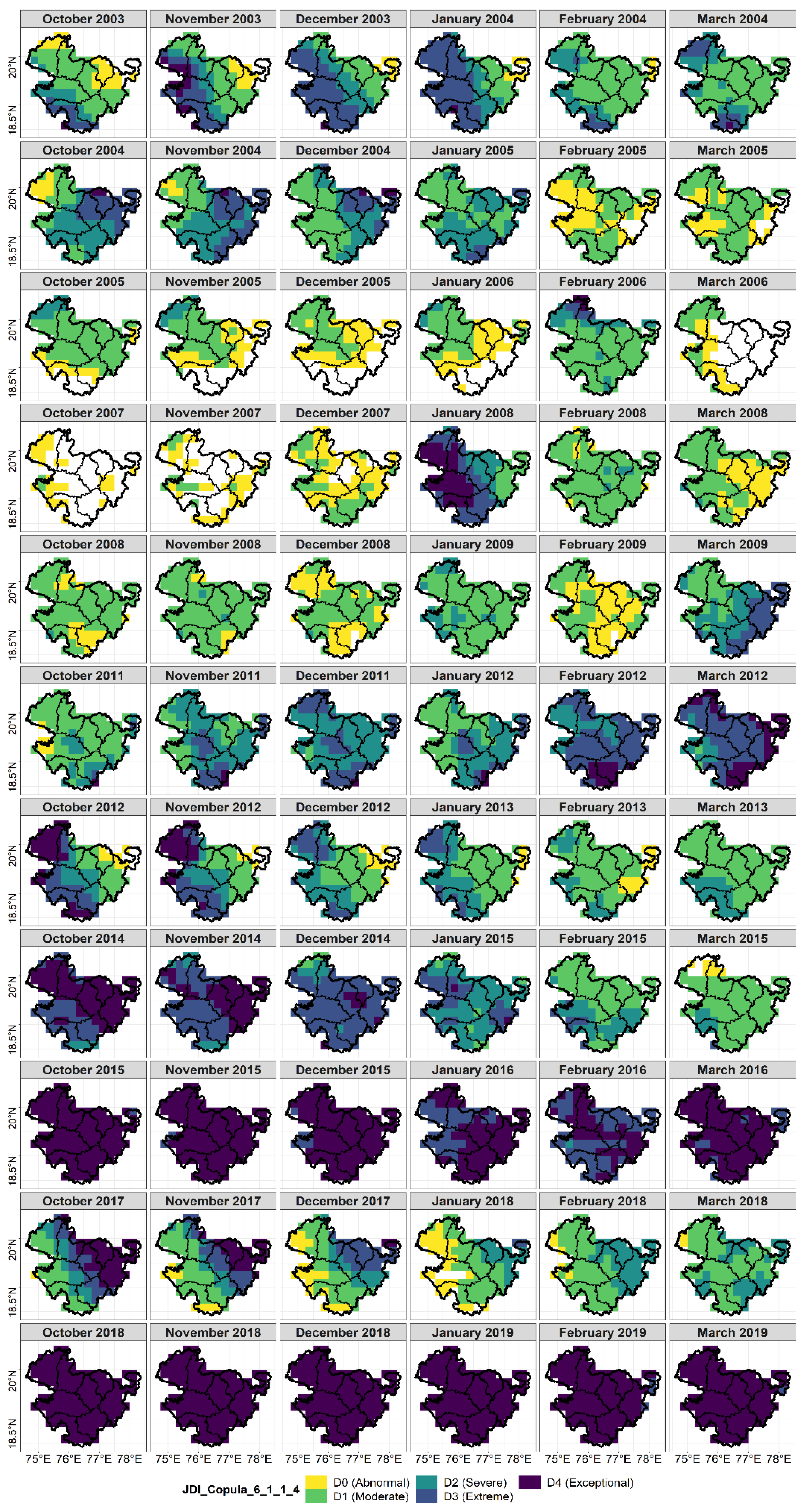


| JDI | Description | Category |
|---|---|---|
| −0.50 to −0.79 | Abnormally Dry | D0 |
| −0.80 to −1.29 | Moderate drought | D1 |
| −1.30 to −1.59 | Severe drought | D2 |
| −1.60 to −1.99 | Extreme drought | D3 |
| −2.0 or less | Exceptional drought | D4 |
| Month | Kharif (June–September) | |||
|---|---|---|---|---|
| SPEI (3 Months) | SSI (1 Month) | SGI (1 Month) | SRI (3 Months) | |
| June | 0.27 | 0.30 | 0.19 | 0.23 |
| July | 0.29 | 0.29 | 0.17 | 0.25 |
| August | 0.29 | 0.26 | 0.19 | 0.26 |
| September | 0.29 | 0.27 | 0.15 | 0.29 |
| Month | Rabi (October–March) | |||
| SPEI (6 Months) | SSI (1 Month) | SGI (1 Month) | SRI (4 Months) | |
| October | 0.29 | 0.25 | 0.25 | 0.21 |
| November | 0.28 | 0.27 | 0.26 | 0.19 |
| December | 0.27 | 0.27 | 0.25 | 0.21 |
| January | 0.28 | 0.27 | 0.24 | 0.21 |
| February | 0.27 | 0.30 | 0.29 | 0.13 |
| March | 0.28 | 0.30 | 0.26 | 0.16 |
| AIC | Gaussian | t-Copula | Joe | Clayton | Gumbel |
|---|---|---|---|---|---|
| JDI_Copula_3_1_1_3 | −427.09 | −424.65 | −231.44 | −256.62 | −297.00 |
| JDI_Copula_6_1_1_4 | −433.36 | −430.86 | −248.73 | −290.79 | −327.24 |
| BIC | Gaussian | t-copula | Joe | Clayton | Gumbel |
| JDI_Copula_3_1_1_3 | −411.86 | −405.91 | −218.42 | −281.12 | −284.74 |
| JDI_Copula_6_1_1_4 | −417.22 | −411.06 | −252.95 | −296.89 | −327.91 |
Publisher’s Note: MDPI stays neutral with regard to jurisdictional claims in published maps and institutional affiliations. |
© 2022 by the authors. Licensee MDPI, Basel, Switzerland. This article is an open access article distributed under the terms and conditions of the Creative Commons Attribution (CC BY) license (https://creativecommons.org/licenses/by/4.0/).
Share and Cite
Bageshree, K.; Abhishek; Kinouchi, T. A Multivariate Drought Index for Seasonal Agriculture Drought Classification in Semiarid Regions. Remote Sens. 2022, 14, 3891. https://doi.org/10.3390/rs14163891
Bageshree K, Abhishek, Kinouchi T. A Multivariate Drought Index for Seasonal Agriculture Drought Classification in Semiarid Regions. Remote Sensing. 2022; 14(16):3891. https://doi.org/10.3390/rs14163891
Chicago/Turabian StyleBageshree, K., Abhishek, and Tsuyoshi Kinouchi. 2022. "A Multivariate Drought Index for Seasonal Agriculture Drought Classification in Semiarid Regions" Remote Sensing 14, no. 16: 3891. https://doi.org/10.3390/rs14163891
APA StyleBageshree, K., Abhishek, & Kinouchi, T. (2022). A Multivariate Drought Index for Seasonal Agriculture Drought Classification in Semiarid Regions. Remote Sensing, 14(16), 3891. https://doi.org/10.3390/rs14163891





